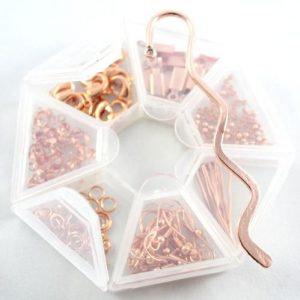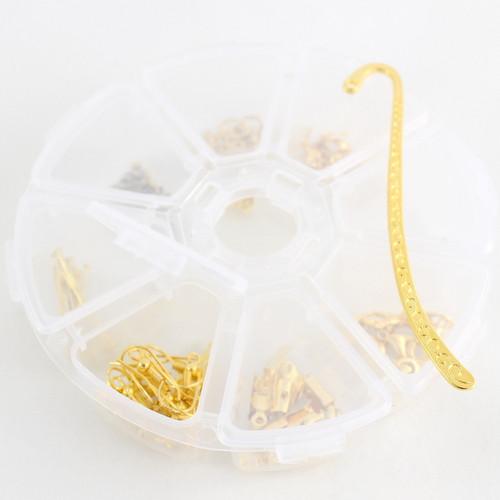Ever wondered what the 925 stamp on silver means and what’s the difference between 9, 18 and 24 carat gold? Precious metals surround us every day in the jewellery making world, and this blog will delve into how they are created and what each marking means.
Silver
Have you noticed that your ring has a stamp on it that says 925? Well that’s called a Hallmark and it indicates that a piece is made from what’s known as Sterling Silver. The 925 hallmark means that it has a pure silver content of 92.5 percent mixed with 7.5 percent copper. Sterling silver is strong and durable which makes it perfect for jewellery making. It can be shaped into rings, necklaces, bracelets, etc and is strong enough to be continually buffed to a shine without the surface being compromised.
Other types of silver have a slightly lower pure content, making them a better material for goblets, picture frames, vases, etc.
We use a different type of silver in my workshops. We use silver art clay, moulding and shaping it into some amazing pieces of hand crafted jewellery. Once you’ve created your piece we pop it into a kiln and hey presto, suddenly it’s real silver! Silver art clay consists of very fine particles of pure silver (fine silver clay has a 99.9% pure silver content) mixed with a non-toxic, organic binder. The binder is what makes it like clay and this burns out during firing, leaving you with a pure silver piece.
It is so much fun and you really do get stunning results. If you’d like to join us on one of these courses please click here.
Gold
Gold used for jewellery is generally a mixture of pure gold plus other metals such as silver, copper, nickel and zinc. Carats ct (or Karats kt) are the measurement of pure gold content within the metal mix. Much like silver, hallmarks are stamped onto a piece to reveal the gold content as a three digit number. Here’s the most popular types of gold you’ll find in the Western world today, their hallmarks and what percentage of pure gold each one equates to:-
- 9 carat Gold – Hallmark 375 – Gold content equals 37.5%,
- 14 carat Gold – Hallmark 583 – Gold content equals 58.3%
- 18 carat Gold – Hallmark 750 – Gold content equals 75%
- 24 carat Gold – Hallmark 999 – Gold content equals 99.9% or above
So you see the more pure the gold, the higher the carat/karat, plus it becomes a lot more soft and malleable. This is why 24 carat gold isn’t really very suitable for jewellery design, plus it’s a LOT more expensive.
Most gold colours have their colour slightly dictated by the components they are mixed with:
- Pure gold is yellow in colour.
- Yellow gold is the alloy of pure gold, silver and copper or zinc.
- White gold is the alloy of pure gold and white metals, such as nickel, silver and palladium. White gold is normally plated with rhodium to give it a whiter look.
- Rose gold is the alloy of pure gold and copper.
- Green gold is exactly like yellow gold, except copper is left out of the alloy. You don’t hear as much about green gold in the UK, but you’ll see lots of it if you venture to India or Northern Africa.
Gold/Silver Plated
We work a lot with gold and silver plated findings and charms. The silver, rose gold and yellow gold clasps, jump rings and other pieces that we sell at Riverside Beads are all plated with precious metals. This means that they are dipped into gold or silver to produce a light coating. The base metal used underneath that coating is usually iron, copper, brass or titanium.
You can buy Sterling silver and gold findings (jump rings, clasps, chain, etc.) but they are quite costly so it’s not recommended for the novice jewellery maker. Wait until you’ve mastered the use of the plated jump ring, so you don’t end up with an expensive mistake!
Try our wide selection of findings which are nearly all plated. For a special piece I highly recommend the rose gold ones as they have a beautiful patina to them. Click here to see more.

Silver and Gold Filled
Silver and gold filled metals are another popular choice for jewellery making. Silver or gold filled wires are made by using heat and pressure to apply a layer of silver/gold to a base of a cheaper metal.
These layers are much thicker than a standard plating. This means you can polish your silver/gold filled jewellery more than plated counterparts and even do some light engraving without exposing the base metal underneath. Silver and gold filled jewellery tends to be more expensive than plated because of this added thickness.
Platinum
Platinum is the most rare and the most expensive of all of the metals. The price reflects how strong it is. It really is incredibly durable and will never tarnish. Platinum can be alloyed with copper, cobalt, ruthenium, rhodium, palladium, osmium or iridium.
There are four recognised hallmarks of platinum:
- 850 – 85% pure platinum content
- 900 – 90% pure platinum content
- 950 – 95% pure platinum content
- 999 – 99.9% pure platinum content
Titanium
Titanium is a lot cheaper than Platinum but much stronger. In fact it’s the hardest natural metal known to man. It’s a great choice for popular jewellery because it can be coloured easily with dyes or other metals. Plus it’s scratch-resistant, lightweight and completely hypoallergenic. You may see a lot of body piercings are made from titanium or perhaps stainless steel.



Hi, I have an Art Deco style vase, which has hallmark “ATO” & “24” could you help me to identify it please.
Kind Regards
Hi Victor,
We are not experts in hallmarks so I would recommend contacting somewhere like Southebys online estimate service. It is free and they are the experts, so should be able to help you. 🙂